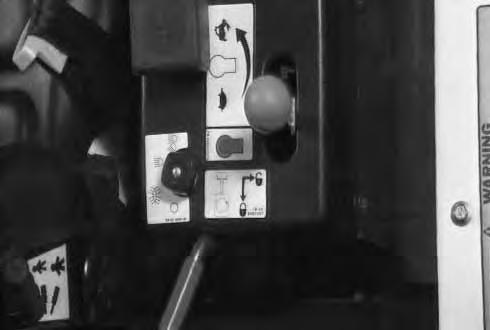
3 minute read
STARTING THE ENGINE (Cont’d)
Avoid Injury Or Death
When an engine is running in an enclosed area, fresh air must be added to avoid concentration of exhaust fumes. If the engine is stationary, vent the exhaust outside. Exhaust fumes contain odorless, invisible gases which can kill without warning.
W–2050–1285
• Engines can have hot parts and hot exhaust gas. Keep flammable material away.
• Do not use machines in atmosphere containing explosive gas.
W–2051–1086
Cold Temperature Starting Condition
Use the following procedure to make starting easier: Replace the engine oil with correct type and viscosity for the anticipated starting temperature. (See Oil Specifications Page 52.)
Make sure the battery is fully charged. Install a tank heater on the engine.
Do not use ether with glow plug (preheat) systems. Explosion can result which can cause injury or death.
W–2071–1285
Push the engine speed control lever fully forward (Position 2) [A].
Turn the key to HEAT position, the light will come on [B]. Preheat the engine for 15 seconds maximum.
Turn the key to START position and start the engine [C].
Release the key, and it will return to the run ON position.
When the engine speed increases, move the engine speed control lever immediately to low idle (Position 1) [A]
PI–02824
Do not engage the starter for longer than 15 seconds at a time. Longer use can damage the starter by overheating. Cool the starter for one minute between uses.
I–2034–0284
OPERATING PROCEDURE Breaking In A New Machine
When operating on a public road or highway, always follow local regulations. For example: Slow Moving Vehicle Sign or Directional Signals may be required.
A new machine requires careful operation during the first 100 hours to break in various parts.
If a machine is subjected to hard use during the initial operation, the performance and service life will be reduced.
Do the following when operating a new machine:
• After starting, let the engine idle for 5 minutes so the engine and components can warm up.
• Avoid operation with heavy loads or at high speeds.
• Avoid sudden starting or stopping or abrupt motions.
General Operation Suggestions
Know where the first aid kit and fire extinguisher are and know how to use them. Also know how to contact emergency assistance.
When operating on uneven ground or in places where there are obstacles, do the following:
• Operate as slow as possible and avoid sudden changes in direction.
• Avoid traveling over objects (such as rocks, trees, stumps, etc.).
When working in wet or soft ground, put planking on the ground to prevent the machine from getting stuck. If the machine is stuck in soft soil, use the following procedure to move the machine to firm ground:
1.If one track or both tracks are stuck in soft soil, push the bucket down against the ground to raise the track (or tracks, one side at a time) off the ground.
2.Place timber (planks) under the track(s) and drive the machine to firm ground.
3.It may help to put the bucket into the ground in front and move the arm as if you were digging to help move the machine.
When operating in water or crossing streams, first check the soil conditions, depth and flow of water. Never operate in water higher than the bottom of the swing circle.
NOTE:Be careful when removing the machine from water. The engine may become filled with water and damage could result.
Do not operate the machine when visibility is poor (fog, mist or smoke).
If it is necessary to operate the control levers when moving the machine near a cliff, road shoulders, or sloping ground, stop the machine travel before operating any work equipment levers.
Do not dig under the machine.
Check with utility companies, for underground electrical, water, gas lines, etc. Work slowly in areas of underground utilities.
Do not allow the bucket teeth to contact the groundwhen swinging the upperstructure.
Do not move the machine with the bucket in the ground or trench.
Do not use the bucket as a breaker or pile driver. It is better to excavate hard or rocky ground after breaking it with other equipment. This will reduce damage to the machine.
To brake the machine when going down a slope, put the steering levers in NEUTRAL position. This will engage the hydrostatic braking.
When the engine stops on a slope, move the steering levers to the neutral position. Lower the boom/bucket.
NOTE:The left hand control console must be in the locked down position, with the engine stopped, to activate the accumulator pressure to lower the boom/bucket (attachments) to the ground.
NOTE:The key switch must be in the ON position with the engine stopped to activate the accumulator pressure to lower the boom/bucket to the ground.
Start the engine and resume the operation.






